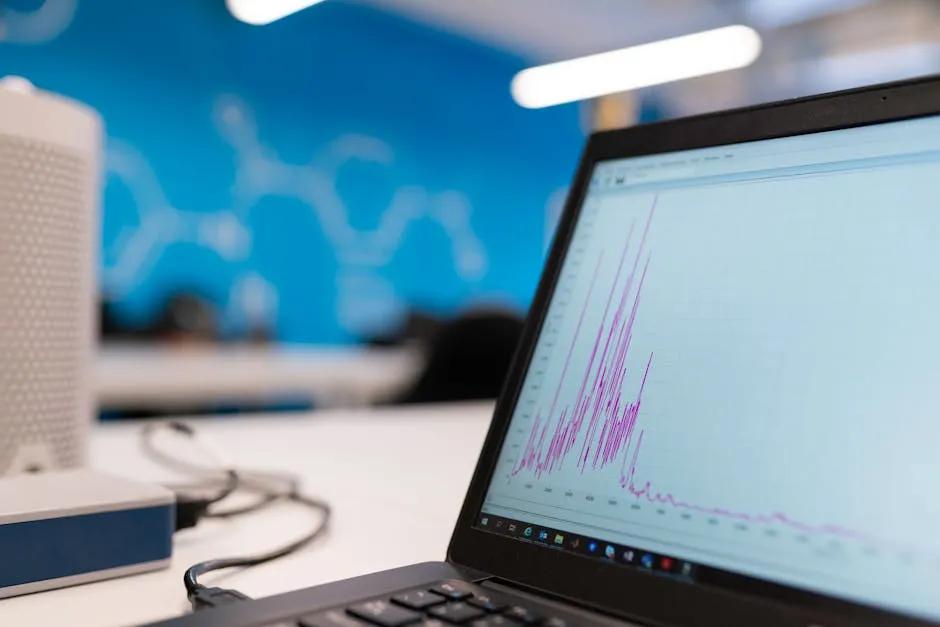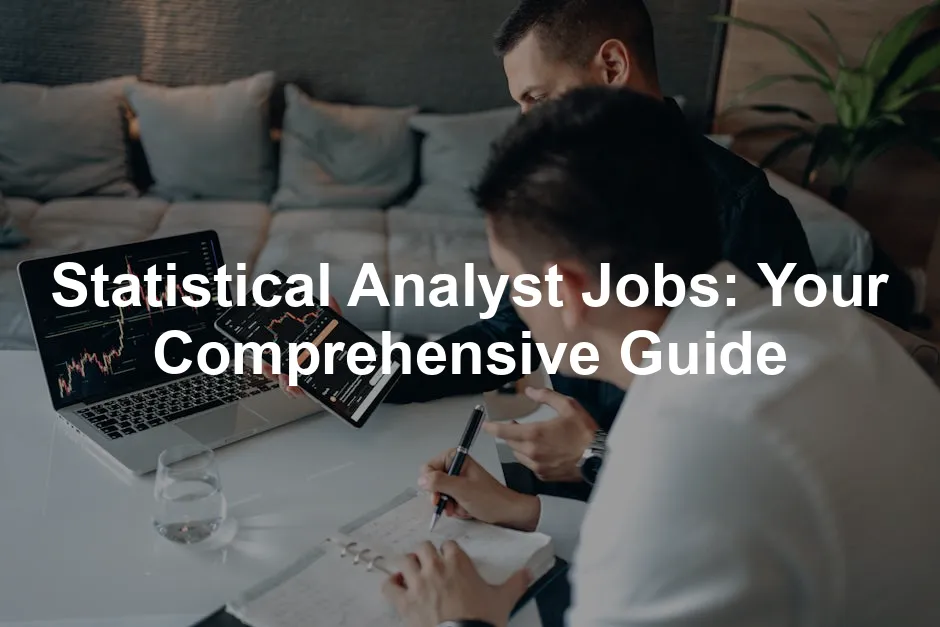Introduction
Statistical analysts are the unsung heroes of data. These professionals transform raw numbers into meaningful insights, helping businesses make informed decisions. By utilizing statistical methods and software, they analyze data trends and patterns, making sense of complex information. Their role is essential across various industries, from finance to healthcare, marketing to government sectors.
In finance, for instance, statistical analysts help in risk assessment and investment strategies. In healthcare, they analyze patient data to improve treatment outcomes. Marketing professionals rely on their expertise to understand consumer behavior and optimize campaigns. Therefore, statistical analysts play a vital role in enhancing operational efficiency and supporting organizational growth.
The purpose of this article is to provide a thorough examination of statistical analyst jobs. We will cover job descriptions, necessary skills, salary expectations, job outlook, and tips for aspiring analysts. Whether you’re just entering the field or looking to advance your career, this guide serves as a valuable resource.
To ensure the article reaches a wide audience, we will include relevant keywords and phrases. This optimization strategy will enhance our visibility on search engines, making it easier for those seeking information about statistical analyst positions to find us. So, let’s get started on this exciting journey into the world of statistical analysis.

Understanding the Role of a Statistical Analyst
What is a Statistical Analyst?
Statistical analysts are data detectives. Their primary responsibility is to collect, analyze, and interpret data to assist organizations in making strategic decisions. They utilize statistical methods to identify trends and patterns, turning numbers into actionable insights.
In the finance sector, statistical analysts evaluate market trends, helping companies manage risks and maximize profits. In healthcare, they analyze patient outcomes, contributing to advancements in medical treatment. Marketing teams depend on their skills to understand customer preferences, allowing for targeted strategies.
Statistical analysts find employment in a variety of industries.
- Finance: They assess investment risks and returns.
- Healthcare: They interpret patient data and improve treatment plans.
- Marketing: They analyze consumer behavior to enhance advertising efforts.
- Government: They provide statistical support for policy-making and public health initiatives.
In summary, statistical analysts are vital to the data-driven decision-making process across multiple sectors. Their analytical prowess allows businesses to navigate the complexities of data effectively.

Key Skills Required
Technical Skills
To excel as a statistical analyst, technical know-how is crucial. Proficiency in programming languages like R Programming for Data Science by Hadley Wickham and Python for Data Analysis by Wes McKinney is essential. These languages help analysts manipulate data and perform complex statistical analyses. Additionally, familiarity with statistical software such as SAS Essentials: Mastering SAS for Data Analytics and SPSS Statistics for Data Analysis is a must. These tools allow analysts to apply a variety of statistical techniques efficiently. Not to mention, they streamline data visualization and reporting processes. In today’s fast-paced data environment, these skills set candidates apart and enhance their job prospects.

Soft Skills
While technical skills are important, soft skills also play a significant role. Critical thinking allows analysts to interpret data accurately and make sound decisions. Problem-solving skills are equally vital, as analysts often face unique challenges in their work. They need to devise innovative solutions based on data findings. Communication skills cannot be overlooked, either. Analysts must convey complex information in a way that stakeholders can easily grasp. This blend of skills ensures that statistical analysts not only crunch numbers but also tell compelling stories with data.
Job Market Overview
Current Demand for Statistical Analysts
Statistics and Trends
The demand for statistical analysts is booming! Recent data shows that the job market is more vibrant than ever. Currently, there are approximately 371 active jobs for data analysts alone. Over the past three months, there has been a remarkable growth rate of 83.7%. This surge translates to 169 new job openings in a short span. Such figures indicate a robust need for skilled professionals who can handle data analysis and interpretation.

Top Locations
When it comes to geographical hotspots, certain cities lead the charge in hiring statistical analysts. Berlin tops the list with 12.7% of job openings, followed closely by Hamburg at 8.4%. Other prominent locations include Düsseldorf and Munich, each with a solid 4.9% share. Frankfurt am Main also makes the cut with 3%. These cities are not just vibrant cultural hubs; they are also thriving centers for data-driven industries. If you’re targeting a career in statistical analysis, these locations should be on your radar for job hunting. The growing demand in these areas showcases the critical role statistical analysts play in shaping business strategies and outcomes.
In summary, the job market for statistical analysts is experiencing significant growth. This trend is driven by the increasing reliance on data across various sectors. Those equipped with the right skills can find ample opportunities and a bright future in this dynamic field.

Career Level Distribution
The statistical analyst job market features a variety of career levels. Entry-level positions often require a bachelor’s degree in statistics, mathematics, or a related field. Fresh graduates typically handle basic data analysis tasks. They assist senior analysts with data collection and initial analysis, gaining valuable experience along the way.
As analysts progress, they take on more complex projects. At the mid-level, professionals often lead smaller teams. They are expected to manage specific projects, ensuring data accuracy and meaningful insights. Senior positions demand extensive experience and expertise. Senior analysts often mentor junior staff and play a strategic role in decision-making. They are responsible for translating complex statistical concepts into actionable recommendations for stakeholders.
This career ladder provides opportunities for growth, making the field appealing to aspiring analysts.

Salary Expectations
Average Salary Data
In terms of compensation, statistical analysts can expect varying salaries based on experience and location. Entry-level analysts typically earn between $55,000 and $70,000 annually. Meanwhile, mid-level professionals see an increase, with salaries ranging from $70,000 to $90,000. Senior analysts, with their wealth of experience, can command salaries from $90,000 to over $120,000. Geographic location also plays a crucial role in salary variations. Analysts in major cities like San Francisco or New York tend to earn significantly higher wages due to the higher cost of living.

Comparison with Similar Roles
When comparing salaries to similar roles, statistical analysts often find themselves in a competitive position. Data analysts, for instance, generally earn slightly less, with average salaries ranging from $50,000 to $85,000. Conversely, data scientists, who typically have more advanced skills, can earn between $95,000 and $140,000. This comparison shows that while statistical analysts may not be the highest-paid, they still enjoy a respectable salary, especially as they gain experience and expertise in their field.
Overall, the salary landscape for statistical analysts is promising, reflecting the crucial role they play in data-driven decision-making.

Reporting Findings
Statistical analysts are like skilled storytellers, but instead of words, they use data. Their mission? To turn complex numbers into clear insights for stakeholders. Presenting findings is not just about sharing results; it’s about making them understandable and actionable.

Analysts often create reports filled with graphs, charts, and tables. These visual tools help convey trends and patterns at a glance. Imagine trying to explain a complicated concept without visuals. It’s like trying to tell a joke without the punchline—confusing and, well, not funny!
When presenting their findings, analysts must tailor their message to the audience. Executives might want a high-level overview, while technical teams may appreciate a deep dive into the methodology. Striking the right balance is key. Analysts must ask themselves: “What does my audience need to know?” and “How can I make this engaging?”
Communication doesn’t end with reports. Presentations often accompany them. Analysts must confidently present their findings, answering questions and sparking discussions. This is where soft skills shine. Clear communication is essential to ensure that stakeholders grasp the insights and feel empowered to make informed decisions.

Tools and Technologies Used
In their toolkit, statistical analysts rely on various software to perform their magic. Here are some commonly used tools:
- Tableau: Visual storytelling is made easy with Tableau. This powerful tool allows analysts to create interactive and shareable dashboards, bringing data to life.
- Excel 2019 for Dummies: The classic! Analysts often use Excel for data manipulation and preliminary analysis. It’s a versatile tool that’s likely found on every analyst’s computer.
These tools not only enhance productivity but also enable analysts to extract meaningful insights efficiently. The right technology can transform tedious data tasks into streamlined processes, helping analysts focus on what truly matters—drawing insights and making data-driven decisions.

For those looking to enhance their skills in data manipulation, descriptive statistics in Excel can be a great resource.
Certifications
Certifications can give you an edge in the competitive world of statistical analysis. They signal to employers that you possess the necessary expertise. Consider pursuing certifications like the Certified Analytics Professional (CAP) or the SAS Certified Statistical Business Analyst. These credentials showcase your skills in statistical methods and data analysis, enhancing your job prospects. Additionally, certifications in specific tools, such as Google Data Analytics or Microsoft Certified: Data Analyst Associate, can make your resume stand out.

For those interested in gaining practical experience, check out statistics internships summer 2024 for valuable opportunities.
Gaining Experience
Internships and Entry-Level Positions
Getting your foot in the door is essential. Internships or entry-level positions provide hands-on experience, allowing you to apply classroom knowledge in real-world settings. These roles often involve assisting senior analysts, offering invaluable exposure to data analysis processes. They help you build connections and gain insights into the daily tasks of a statistical analyst. Remember, every experience counts and can set the stage for future opportunities.
Networking and Professional Development
Networking is key in this industry. Attend industry conferences, join data analytics groups, and connect with professionals on platforms like LinkedIn. Don’t shy away from asking questions or seeking advice. Finding mentors can significantly accelerate your learning curve. They can provide guidance, share experiences, and help you navigate your career path. Remember, relationships matter; they can open doors to job opportunities that aren’t always advertised.

Job Application Tips
Resume and Cover Letter Writing
Crafting a standout resume and cover letter is crucial. Tailor your documents for each application. Highlight relevant skills, experiences, and certifications that align with the job description. Use active language and quantify your achievements where possible. A well-structured resume communicates professionalism and attention to detail. Your cover letter should tell a story—show your passion for data and how your skills can benefit the company.

Interview Preparation
Interviews can be nerve-wracking, but preparation can ease the anxiety. Familiarize yourself with common interview questions, such as “How do you handle missing data?” or “Can you explain a complex statistical concept?” Practice articulating your responses. Use the STAR method (Situation, Task, Action, Result) to demonstrate your problem-solving abilities. Remember, confidence is key—showcase your skills and knowledge, and don’t forget to ask thoughtful questions about the company and role.
Please let us know what you think about our content by leaving a comment down below!
Thank you for reading till here 🙂
If you’re looking to delve deeper into statistical analysis, consider grabbing The Data Warehouse Toolkit by Ralph Kimball. This book provides essential insights into effective data architecture that every analyst should know.
For those who want to explore the world of data visualization, The Visual Display of Quantitative Information by Edward R. Tufte is a must-read. It offers a unique perspective on how to present data effectively, making your findings more impactful.
Finally, if you’re interested in understanding the intersection of data and business, Data Science for Business by Foster Provost dives into how data science can drive business decisions and strategy.
All images from Pexels




